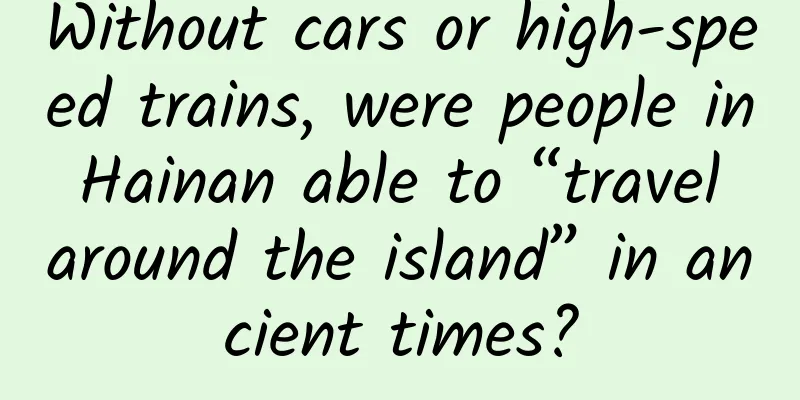Without cars or high-speed trains, were people in Hainan able to “travel around the island” in ancient times?

|
Roads are the main arteries of a city. From the ancient island-circling post roads to the Haiyu East, Central and West lines after the founding of New China , the island-circling expressway started in the 1990s , the island-circling high-speed railway that was fully opened in December 2015 , and the island-circling tourist highway that will be fully opened in December 2023 . The constantly improving road network epitomizes Hainan's development process. In this issue of "Scientific Hainan Tour", we will learn about Hainan's ancient land transportation route - the Ring Island Post Road. How did the earliest road around the island come about? It was probably because "there was no road on the ground, but as more people walked on it, it became a road". The development of land transportation on Hainan Island started with only road traces , which later formed pedestrian paths , dirt roads, and mountain roads . After the Qin and Han dynasties, roads were built for military conquests and to rule the people. Post stations began to appear in the Tang Dynasty , and roads connected counties along the coast. The number of roads increased in the Yuan Dynasty, and post roads flourished in the Song Dynasty. There are records of road and bridge construction. In the Ming Dynasty, Hainan opened a post road around the island , which is now called " Ring Island Post ". For hundreds of years, it has been the most important transportation artery of the island. The post road that is open to the whole island not only carries the function of delivering official documents and letters, but also becomes a major transportation route connecting various places in Qiongzhou. In the early Ming Dynasty, the Ring Island Post (East Road Post and West Road Post) both started from Qiongzhou Prefecture and ended at Yazhou, just circling the island. The cover of the book "Qiongya Ancient Post Road" written by Hainan historian He Yiduan is a general map of the Qiongdao Post Road in the Ming Dynasty: starting from today's Haikou, starting from Qiongtai Post Station to the east, passing through 12 post stations such as Wenchang Post Station, Wanquan Post Station, Wushi Post Station, Boji Post Station, and arriving at Chaoyuan Post Station (located in today's Yazhou District, Sanya City), this route is the East Post Road. From Chaoyuan Post Station, continue to walk westward, from south to north, you will pass through 13 post stations such as Yining Post Station, Changjiang Post Station, Gudan Post Station, Zhuya Post Station, Tongchao Post Station, and finally return to Qiongtai Post Station. This route is called the West Post Road . The Qiongya Post Road has existed since ancient times. Why is the general map of the Qiongdao Post Road in the Ming Dynasty selected as the full picture of the Qiongya Ancient Post Road? It turns out that after research and deduction, He Yiduan believes that the existing Hainan Ancient Post Road with complete records was restarted in an orderly manner in the third year of Hongwu in the Ming Dynasty (1370). Its efficiency is reliable and reflects the leading level of Chinese culture. Many sections of the road are the inheritance of the earlier Song and Yuan routes. According to the Ming Dynasty records, the lengths of the east and west wings of the Huandao Post were 1110 li and 1120 li respectively, a total of 2230 li . In ancient times, the post roads around the island were equipped with post stations (post houses), post pavilions, post officials, post messengers, post soldiers, and post horses according to local conditions, forming a fully functional post service system. The "Qiongtai Chronicle" of the Ming Dynasty Zhengde recorded: "Qiong is a county surrounded by the sea, starting from Qiongshan in the north and ending at Yazhou in the south. Although the road is divided into three routes, east, middle, and west, they all run from north to south, and the east and west routes are limited to the sea. Therefore, the post stations are listed separately, and the post houses are also listed accordingly, so that it is convenient to visit." For thousands of years, the post road was the main channel for ancient land transportation on Hainan Island, laying the basic pattern of transportation on Hainan Island, promoting trade exchanges and promoting cultural popularization. By the end of the Qing Dynasty and the beginning of the Republic of China, with the development of economy and society, the post road around the island gradually withdrew from the stage of history. Note: The content is based on Hainan Daily, Hainan History and Records Network, etc. The pictures are from the Internet and are only used as popular science materials. If there is any infringement, please contact us. |
Recommend
Baidu bidding quality, how to improve the quality of Baidu bidding keywords?
Recently, the quality of some of the company'...
Lin Qiaozhi's 120th birthday: The lifelong unmarried "mother of ten thousand babies"
Today marks the 120th birthday of Dr. Lin Qiaozhi...
Stop stepping on the toilet seat! Your toilet seat may be dirtier than the public toilet!
Dirty and unhygienic...this is what many people t...
Go to Ningxia and unlock the treasure world!
Ningxia Definitely beyond your expectation Treasu...
"Wuwei Investment Course" Fu Gang established a stable and profitable trading system
"Wuwei Investment Course" Fu Gang estab...
Tianzhou-4 sets sail, China's space station gets new features
At 1:56 a.m. on May 10, the Long March-7 carrier ...
What to do if adverse reactions occur? A complete guide to children's vaccinations, recommended to save!
Today is National Children's Vaccination Awar...
Simply copy and paste, you can easily get 100+ traffic a day on Weibo to make money
Hotspot traffic Weibo, the social platform with t...
The "core" of the watermelon is definitely true love! Why is the middle of the watermelon the most delicious? |Expo Daily
Why is the middle of a watermelon the most delici...
How much do you know about mobile biometric authentication?
Part 01: Mainstream biometric authentication meth...
AION Y Plus is a king bomb, with full intelligent driving range
AION Y Plus 610 Smart Driving Edition is launched...
APP promotion scenario: let users actively download your product!
"Scenario-based" is a prerequisite that...
Tesla's Black April: Either Go Mainstream or Go Bankrupt
"Tesla is bankrupt!" Tesla founder Elon...
Reshaping the future of small and medium-sized cities: Framework and path for digital transformation
The insight report "Reshaping the Future of ...
Data | Online advertising revenue exceeded 67 billion in Q2 2016, data drives advertising value increase!
Overview of Internet Advertising Development in Q2...









